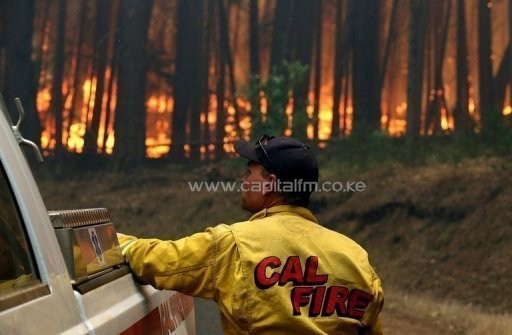
A firefighter hoses a tree as his team work to contain fires from a resident’s backyard at Faulconbridge in the Blue Mountains, New South Wales on October 22, 2013/AFP
Lithgow, Australia October 22- Firefighters on Tuesday deliberately merged two major blazes in southeastern Australia in a desperate battle to manage the advancing infernos as weather conditions worsen.
Crews made up largely of volunteers worked through the night along trails in heavily forested areas west of Sydney to try to prevent the fires becoming one out of control “mega fire” that could race towards a third blaze nearby.
Firefighters have been battling wildfires across the state of New South Wales since they flared in high winds and searing heat last week, with more than 200 homes destroyed so far and many others damaged.
In the state’s worst fire emergency in almost 50 years, dozens of blazes have been extinguished or contained but 60 are still alight and 14 of them deemed out of control.
The Blue Mountains, a popular tourist area, is the main focus of concerns owing to a huge fire in the Lithgow area with a perimeter of 314 kilometres (194 miles).
NSW Rural Fire Service Commissioner Shane Fitzsimmons said the two fires were “deliberately and tactically joined” through backburning a tactic aimed at creating firebreaks to control the path of blazes.
“That is principally focused on trying to stop those two fires coming together and joining with the fire down at Springwood and Winmalee,” he said, referring to a blaze that razed 200 houses last week and which has flared again.
“We are seeing positive results of these very deliberate, very targeted, very decisive strategies being deployed particularly in relation to backburning operations.”
The decision to merge the edges of the infernos near Lithgow and Mount Victoria in the Blue Mountains is aimed at starving the fires of the fuel that would otherwise have allowed them to become the “mega fire” authorities were fearing on Monday.
But while firefighters 1,100 worked through the night, aided by 84 fire bombing aircraft have had “some extraordinary success”, Fitzsimmons warned “there’s still a way to go” with a storm moving towards the area bringing high winds but little rain.
This translated to “very difficult, very dangerous fire behaviour and firefighting conditions”.
“We have got now probably 24 hours before we see the worst of the weather starting to develop and build across all these fire ground areas,” the fire chief added, with strengthening winds and high temperatures expected on Wednesday.
Forecast cooler weather is expected to make conditions more favourable from Thursday.
While claiming some success, with the Lithgow area fire downgraded one notch to a “watch and act” from the highest level “emergency”, it continued to threaten properties near the township of Bell and other villages.
“I plead with people don’t be complacent,” said Fitzsimmons.
In addition to the fires west of Sydney, large tracts of the state remain at risk and under total fire bans.
Wildfires are common in Australia’s summer months from December to February. But an unusually dry and warm winter and record spring temperatures has seen the 2013-14 fire season start early with warnings of a long, tough summer ahead.
As debate rages in Australia on a possible link between the infernos and climate change, United Nations climate chief Christiana Figueres said wildfires are “absolutely” linked to global warming and increasingly intense heatwaves.
She said Australia’s new Prime Minister Tony Abbott’s decision to repeal a carbon tax on emissions designed to combat climate change put in place by the previous government would come at a high price.
“We are really already paying the price of carbon,” she said. “We are paying the price with wildfires, we are paying the price with droughts.”
Data from Australia’s Bureau of Meteorology show that 2013 is on track to become the country’s hottest year on record while last month was the hottest September ever recorded in the country.









































